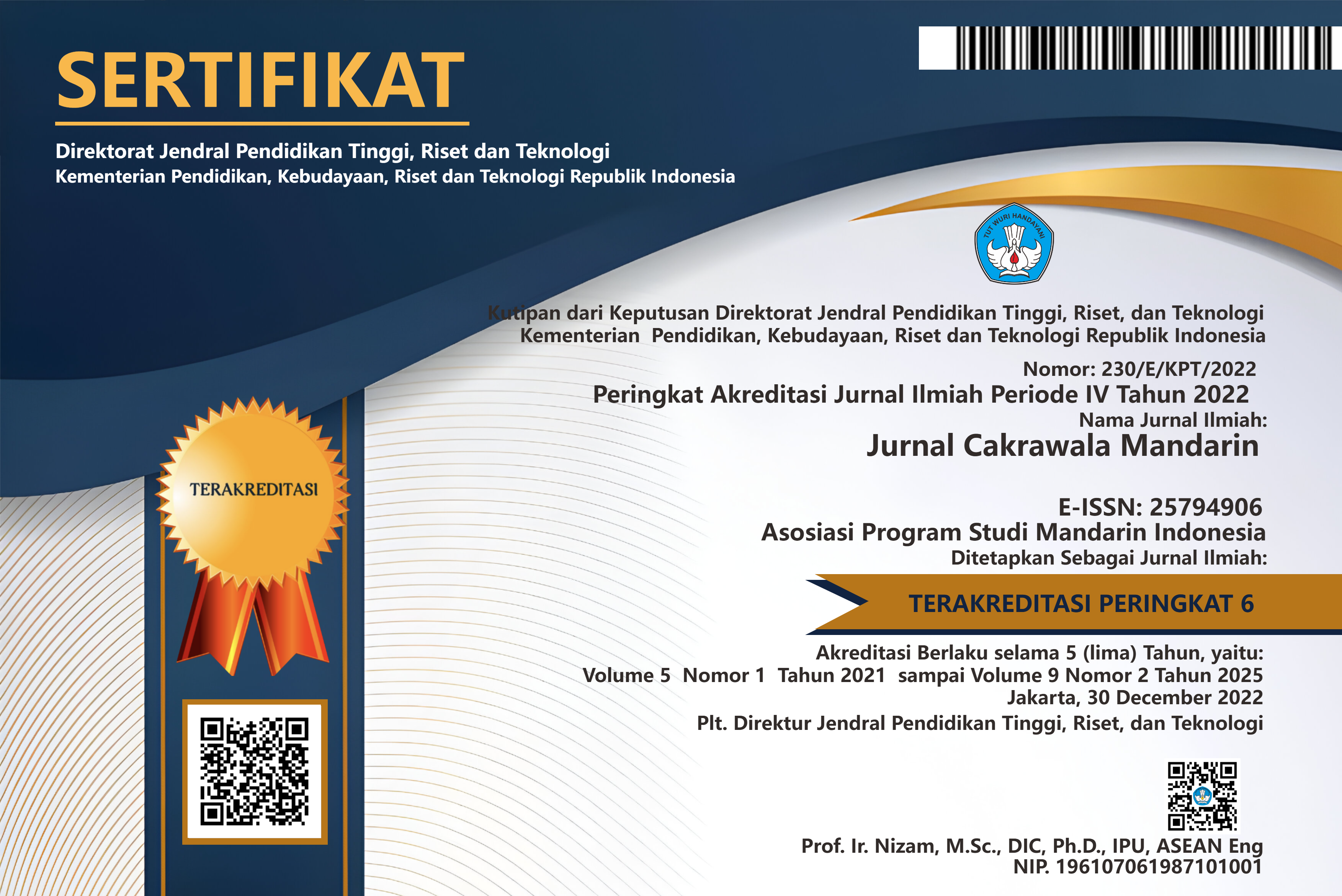国际热爱大自然促进会大自然之歌歌词修辞格分析——以汪慈光先生的作品为代表Analysis of Rhetorical Devices in the Lyrics of “TheSongs of Loving Nature” by the International Nature Loving Federation: A Case Studyof theWorks of Mr. Wang Tzu Kuang
Abstract
Full Text:
PDF (简体中文)References
Aristotle. (1877). Aristotle: Rhetoric (Vol. 1). y Cambridge University Press. Keraf, G. (1988). Diksi dan Gaya Bahasa. Gramedia Pustaka Utama. Siswono. (2004). Teori dan Praktik Diksi, Gaya Bahasa, dan Pencitraan. Deepublish. Suryo Handono, D. A. P., Shintya. (2014). Gaya Pengarang dan Citra PerempuandalamSastra. Balai Bahasa Provinsi Jawa Tengah. 陈望道. (1979). 修辞学发凡. 上海:上海教育出版社. 郭绍虞. (1979). 汉语语法修辞新探. 北京:商务印书馆. 康家珑. (2007). 趣味修辞. 上海古籍出版社. 盛若菁. (2006). 比喻语义研究. 成都:西南交通大学出版社. 孙 静 . (2015). 文 学 作 品 中 比 喻 修 辞 格 研 究. 语文建设(26), 66-67. https://doi.org/10.16412/j.cnki.1001-8476.2015.26.046
谭 永 祥 . (1984). 关 于 借 喻 和 借 代 . 浙 江 师范学院学报(03), 89-93. https://kns.cnki.net/kcms2/article/abstract?v=KetWmXlLxleb2A15o1hrHFJn-Oizo09AJ6mawWXzHLenDAyTwlWMBf9c4AaJMbzlx7nMZMxtZ7TsAPDm5GKrE08mHKvUyNohvYROdCnBBa7fQZVRFPPsPNbmdrCgY85B064tHSP4mk_DHnmUdUSzxljONlCTLGz6-JbgPiNUR-h4dc-wqy24Wqo0BXXf47Dh&uniplatform=NZKPT&language=CHS
谭永祥. (1992). 汉语修辞美学. 北京:北京语言学院出版社. 汪慈光. (2006). 一起活在大自然乐园里. 慈光出版社. 汪慈光. (2008). 十共世界光明颂. 慈光出版社. 汪慈光. (2013a). 清风轻吻我的脸庞. 慈光出版社. 汪慈光. (2013b). 阳光之歌. 慈光出版社. 汪慈光. (2015). 人类的生存之路. 慈光出版社. 王利娟. (2016). 古今文学作品描写人物容貌所用修辞格的差异性. 文教资料(21), 17-18. https://kns.cnki.net/kcms2/article/abstract?v=KetWmXlLxleF10HCIS7HW1QFl6jgRhL5RcjS-lBsSI3aspFlTK9-8Or5_XBjoKeNxEE6CdctMvfRi4vPgRqs6KG_0fwX5Kmi
qXBcv8ulqOTfcvYi4rl6plu4eblwN3ewsyBSu6YYdr7MFMxZMWxVL1GL6xyyXFhKbAqYhDId8DRQbU2jwByS9erZE0502ELdpV0cRYeAwGQ=&uniplatform=NZKPT&language=CHS
王希杰. (2004). 汉语修辞学. 北京:商务印书馆. 王晓梅,李芳芳主编. (2011). 道德经一读就懂 最新双色图文版. 北京:中央编译出版社. 吴礼权. (2006). 现代汉语修辞学. 上海:复旦大学出版社. 吴 礼 权 . (2013). 列 锦 辞 格 的 基 本 类 型 . 平 顶 山 学院学报, 28(06), 115-119. https://kns.cnki.net/kcms2/article/abstract?v=KetWmXlLxlfAR5hG75lqxo6PNgzHeWRT00ElOKJe3GqzfJZ-GfwEGkRonZztHsjfSUumphF7Beweq_KeTtrndy2LDvjHLVf9u-e23Ek20SIR5ON_3Pfw1_rUJbPKbSB8wg1nPQv3BcLjn806A7uqm9sOG1XQF1nIgtnfHlGGsQeE41fo_tTCSTEDKxAN8Ffi&uniplatform=NZKPT&language=CHS肖尧. (2009). 汪慈光:只有自己身心和谐才能更好热爱大自然[Interview]. 杨树达. (1952). 积微居金文说. 中国科学院. 张弓. (1963). 现代汉语修辞学. 天津:天津人民出版社. 张伶俐, 吉. (2011). “龙的传人”一说的由来. 文史杂谈.
DOI: http://dx.doi.org/10.36279/apsmi.v9i1.372
DOI (PDF (简体中文)): http://dx.doi.org/10.36279/apsmi.v9i1.372.g177
Refbacks
- There are currently no refbacks.
Alamat Redaksi: Tlp. +62778473399 - hermanuvers72@gmail.com E-ISSN 2579-4906 |  |




